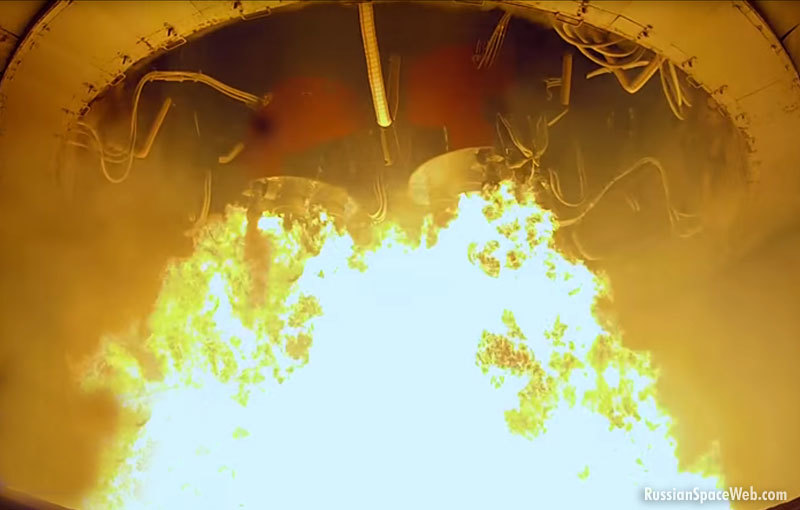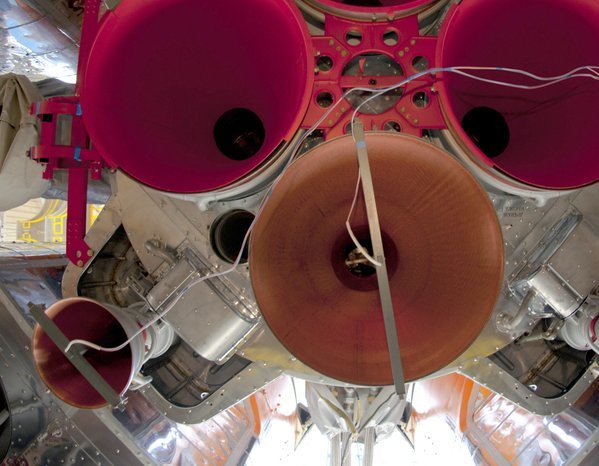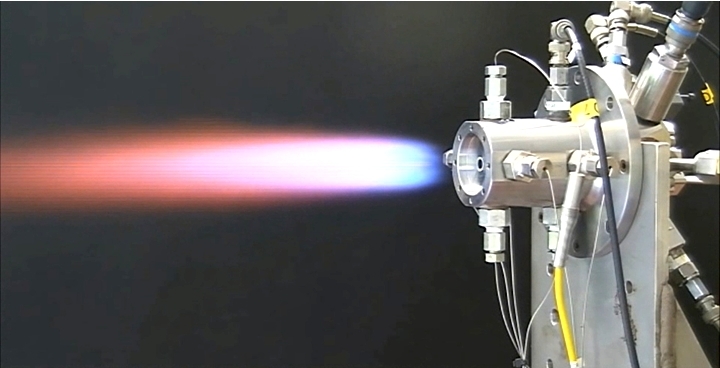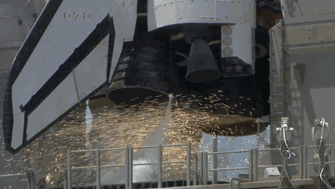32 birch sticks or rocket engine ignition systems

Now, in the twenty-first century, there are space rockets, for the launch of which parts made of wood are used. Thirty-two birch sticks are an important element of the engine start system. And if you probably guessed the country producing such missiles (yes, this is Russia, and the rockets are the Soyuz family), then I would caution you against contempt for such an engineering solution - this would be a serious mistake. Why?
What are we talking about?
The process of launching a liquid-propellant rocket engine is much more difficult than starting, for example, an automobile internal combustion engine. When the pressure, the ratio of components and fuel consumption change in the combustion chamber, transient processes arise that require respect. Improper ignition can lead to a "hard start" and even blow up the engine.
The author of the video writes that he didn’t then find that the combustion chamber and the nozzle were detached:
And here there was a breakdown of the flame of an incendiary device, and the engine received a serious blow when the flame “caught up” with the flow of components:
In search of a reliable, efficient and cheap ignition system, quite a lot of engineering solutions were invented. We will talk about them today.
Rocket grove

This is a pyro igniting device (ROM) for RD-107/108 engines, which are mounted on the Soyuz family carrier rocket. On the wooden T-shaped support there are two pyrotechnic checkers with a sensor (spring-loaded contact) between them. At the “ignition” command, the checkers ignite from the electric igniters, the flame burns through the sensor wire, and its spring opens the contact. A message arrives at the rocket’s electrical system that the checkers are burning well in this combustion chamber, you can open the fuel and oxidizer valves and continue to start the engine.

On top of the two chambers protective covers (bright red), the bottom has already installed a ROM.
Despite the very outdated appearance, this ignition system has the following advantages:
- Cheapness . Any other ignition system will be more expensive because it will require additional pipelines, membranes, valves, etc. A wooden stick and powder checkers cost a penny. Do not forget that the cost of the ignition system is multiplied by the number of combustion chambers, if you have 32 of them, as in the Soyuz, you will want the cheapest option.
- The ability to test the system . The ignition sensor simply and efficiently shows whether the pyroshacks are lit. On March 12 of this year, the first attempt to launch the Resurs-P No. 3 satellite failed for this very reason — piroshashki did not ignite in one of the combustion chambers, and the control system prohibited further engine start
- Quick replacement . It took less than a day for the launch team to replace the ROM and successfully launch Resurs-P # 3 on March 13. Some other ignition systems would require removing the rocket from the launch and delaying the launch for several days.
At the same time, of course, the system has limitations and disadvantages:
- Disposable . Obviously, this method of ignition is not suitable if you need to start the engine several times.
- Requires manual work and depends on its quality . In preparation for the start of the ROM must be installed manually and you can, for example, accidentally damage the wires of the ignition system.
In general, the story of these ROMs clearly demonstrates the saying "the best enemy of the good." For the RD-107/108 engines, other ignition systems were repeatedly proposed, but all the proposals were broken about a simple cost calculation. So, despite the seemingly archaic view, this system will disappear only with the end of the operation of the Soyuz family of missiles, and this will be very soon.
A similar ignition scheme, perhaps without a tree, is used now on the European heavy rocket Ariane 5. Here is a picture of the nozzles of the combustion chamber of the Vulcain 2 engine, which stands on the central stage. In the center there is a hole for piroshashki:

But the checkers assembled in the manufacturer’s workshop:

The installation scheme of the checkers in the engine:

The joy of conspiracy
Adherents of the "lunar conspiracy" are very fond of talking about the launch of Apollo 6 on April 4, 1968 in colors. Indeed, in the process of working the second stage in one engine, problems arose, due to which two engines out of five turned off, and the second stage hardly entered a low orbit. Conspiracy theorists from this event conclude that Saturn-5 turned out to be a useless rocket and could not send anyone to the Moon. But what really happened there?

Diagram of the combustion chamber and igniter engine J-2
In the J-2 engine, which stood on the second and third stages of the Saturn-V booster rocket, the ignition was constantly maintained during its operation. The so-called igniter of the prechamber-flare type was a separate small combustion chamber, into which hydrogen and oxygen were supplied, continuously ignited by an electric discharge from a glow plug (approximately the same as in a car). The flames from the igniter left in the center of the combustion chamber and ensured the continuity of combustion.

The combustion chamber of the SSME shuttle engine using the same principle, the pilot hole is shown by arrow
A in the case of the Apollo 6, problems arose on the approach to the pilot. A thin metal tube through which liquid hydrogen was supplied had flexible elements with corrugations:

Liquid hydrogen is so cold that it liquefies atmospheric air. Under ground test conditions, a layer of liquid air was formed in the grooves of the corrugation, which worked as a shock absorber. And at the height of the launch of the second stage of air was already small, the cushion layer was not formed, the corrugation began to vibrate and burst.

Hydrogen supply stopped, ignition went out, and unstable burning started in the engine. The rocket control system noticed this and gave the command to turn off the engine. But here the second problem manifested itself - the wires to the engines were mixed up, and the control system turned off another, healthy engine. And the first engine went out by itself.
Despite the seriousness of the problems, it was easy to fix them. Corrugated areas were removed in the hydrogen and oxygen supply tubes:

And the wires from the control system were shortened so that it was physically impossible to confuse them. The modified engine was successfully tested in the flight of the Apollo 7. And then the flight of Apollo-8 took place with acceleration to the Moon. Conspiracy theorists who write that the flight to the moon occurred immediately after the Apollo 6 accident are also mistaken here. Alas, they often lack even basic knowledge.
And the electric ignition system with prechamber is successfully used on oxygen-hydrogen engines. If necessary, it can start the engine several times. For shuttles, this was not necessary, but sometimes overclocking units sometimes have to produce several inclusions. Here is a photo from the pilot test for the Vinci European Upper Block being developed:

As for the sparks familiar to many at the start of the Space Shuttle, this is not the engine ignition system. The shuttles were pre-chamber flare igniters (the photo of the combustion chamber is higher, if you have not noticed the signature). As a matter of fact, to start the engine from sparks under a nozzle is almost a sure chance to cause a hard start when the flame rises up to the combustion chamber. Beautiful sparks are a system of guaranteed afterburning of hydrogen from engines so that it does not accumulate anywhere and does not create explosive concentrations.

More about electricity
The convenience of electric ignition made it virtually the only option for starting solid-fuel engines. For example, checkers for ignition of solid-fuel accelerators of the Space Shuttle:

Interestingly, they are not located below the accelerator, as it would seem logical, but above.
Paradoxical option
Sometimes a separate ignition system is not needed at all. Unsymmetrical dimethyl hydrazine and nitrogen tetroxide ignite simply when in contact with each other, eliminating the need for engineers to invent special systems. In addition, UDMH and AT are stored in liquid form at room temperature, making them an excellent choice for manned spacecraft, maneuvering satellites and interplanetary stations. Particularly convenient is the absence of an ignition system for shunting engines that are used in large quantities and differ in small size.

Classics of the genre - the engines of orientation on the "Union" and the lunar module
Chemistry will help
The convenience of self-igniting chemical compounds has led to the fact that they are used as starting fuel for starting non-inflammable fuel pairs. In the simplest case, “ampoules” (pipes with membranes) with self-igniting components are placed in pipelines. When the engine starts, they are released into the combustion chamber, mixed, ignited and create a flame from which the main fuel ignites:

If you need to start multiple times, you can make a separate tank with starting fuel, the supply of which is enough for several starts. Such systems are used quite often on oxygen-kerosene engines, they stood on the F-1 (first stage "Saturn-V"), they are used in the family RD-170/180/190 and "Merlin" Mask. The main drawback of chemical ignition is that if disposable ampoules are used, the membranes burst when launched, and the rocket did not fly away, it has to be removed from the start, taken to the assembly and test complex and replaced with new ones. For example, in 2013, the re-launch of Falcon 9 with the SES-8 satellite took place only six days later.
Pew Pew
In recent years, work has been actively carried out on laser ignition systems. Here, for example, domestic laser modules that have successfully passed the tests on the RD-107/108:

Photos from the tests:

In the future, such systems may displace chemical and pre-chamber electrical ignition, in the case when multiple engine starting is needed, and existing systems are not cheap comparable in value with laser modules.
Simple stories about how rockets and satellites fly - using the tag “Subtle complexities of space technology”
